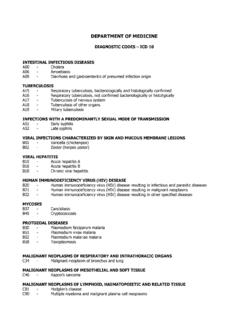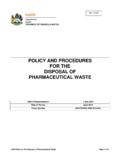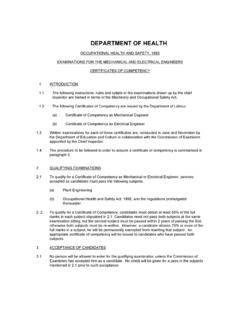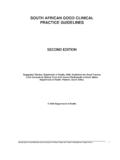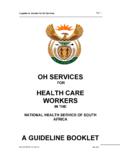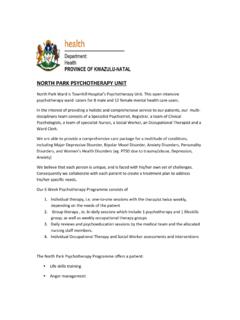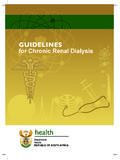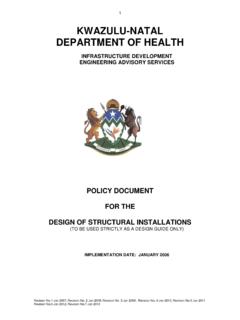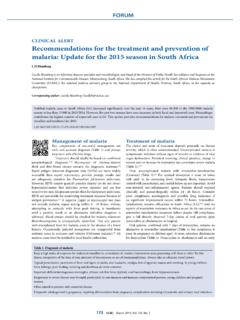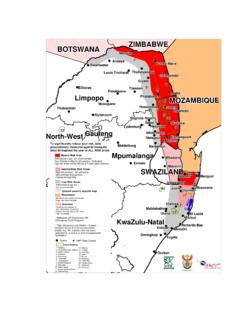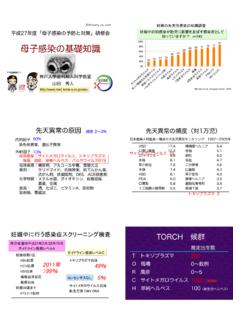Transcription of Dr Vis Poovalingam South African National Blood …
1 Transfusion Transmissible InfectionsDr Vis PoovalingamSouth African National Blood ServiceIntroduction The South African National Blood Service (SANBS) collects approximately 750 000 donations per annum. The organisation is responsible for all aspects related to the collection, processing, testing, cross matching and issuing of Blood and Blood products to all areas of SA excluding the Western Cape. Approximately 900,000 Blood products issued per year . Over 700,000 red cell units 120,000 FFP 57000 platelet concentrates The safety of the Blood supply is a primary concernRegulatory requirementsDeferTestIssue Donor deferral Regular donors Education Target low risk communities Tests as per regulations and standards Preparation of products from low-risk donors Quality system Staff training Accreditation Appropriate use of Blood Blood user education Lookback programme Haemovigilance Quality systemsWhat SANBS DoesVarious steps in the surveillance of Blood transfusion safetyDonorProcessingRecipientGood practices relatedto Blood
2 CollectionGood practicesrelated to bloodprocessingGood practices relatedto distributionWholebloodPlasmaBuffy coatRCC+4 Cmax. 42daysHospitaltraceableHospitaltransfusi onRecipientfollow-upDonorregistryRecipie ntregistry*medical interview*physician's trainingBlood donationDonorsHaemovigilanceStandardsTra nsfusion safety*Leucocyte removal*Phenotyping*CMV serology*Gamma irradiation*Plasma removal*FreezingVirologicalscreeningImmu nologicalscreeningCandidates for donation(% excluded)Potential donorsActual donorsBloodcomponentqualificationGoodpra cticesrelated tostorageDistribution tocrossmatchlaboratories*Biologicaltests *Look-backHaemovigilance5.
3 Known PathogensFor which no assay is available7. LeukocytesAdverse immune responses1. BacteriaIntroduced during collection2. Window Period4. Emerging/UnknownVirusesRisks Exist Risks Exist for Blood Transfusionfor Blood TransfusionTransfusion Recipient3 Imunologic reactionsEg Haemolytic, immunologic reactionsEg circulatory overload HIV transmission is often the key focus area at the expense of other risks The leading course of death related to Blood transfusion is incompatible transfusion as a result of clerical errorWhat is the Risk of HIV Transmission by Blood ?xRoutinely ScreenedYes NoFamilyPathogenDiseaseHepatitis virusesHBV, HCVH epatitis XHEV, HGVH epatitisXRetrovirusesHIV-1 & -2 AIDSXHTLV-I & -IIMalignant lymphoproliferativeXdisorders, neuropathHerpes virusesCMVCMV retinitis, hepatitis,pneumoniaXEBVE pstein-Barr SyndromeXHHV-8 Kaposi s SarcomaXParvovirusesB19 Aplastic anemiaXBacteriaGram-negative.
4 Gram-positiveSepsisXTreponema pallidumSyphilisXBorrelia burgdorferiLyme diseaseXRickettsia rickettsiiRocky Mountain Spotted FeverXEhrlichia chafeensisEhrlichiosisXParasitesTrypanos oma cruziChagas diseaseXBabesia microtiBabesiosisXLeishmania donovaniLeishmaniasisXPlasmodium Known to be Transmitted Pathogens Known to be Transmitted by Blood Transfusionby Blood TransfusionBlood Safety Procedures At Donor site prior to donation self exclusion health questionnaire Donor deferral and code registry Confidential Unit Exclusion Interview with nursing sisterThe impact of donor selectionHIV rate population ~150/ 1 000 HIV rate all donors / 1 000 HIV rate LP donors / 1 000arbitraryHIV rate antenatal attendees ~245/ 1 000 Screening tests for certain diseases performed on every Blood donation Hepatitis B surface antigen (HBsAg) Anti-hepatitis C antibody (anti-HCV antibody) Anti-HIV 1&2 antibody Nucleic acid amplification test (NAT)
5 For HIV-1, HCV and HBV TPHA for syphilisViralRNA/DNAD etectionViral AntigenDetectionAntibodyTestingSurrogate Marker Serum ALT T-cell count Anti-HIV 1,2 Anti-HBc Anti-HCV Anti-HTLV HIV p24 Ag HBsAg HCV Ag NAT HIV-1 HCV HBVNAT is the only direct test for the infectious window period to detectionProgress in Detection of Transfusion-Transmitted PathogensEarlier Viral Detection = Safer Blood SupplyPathogenInactivationInactivates viral and bacterial RNA/DNAN ucleic Acid Testing(NAT) Individual Donation Nucleic Acid Amplification Testing (ID-NAT) was introduced in the South African National Blood Service on 3 Oct 2005. Routine Screening for HIV:p24 ag was discontinued.
6 Serological screening for anti-HIV 1&2, HBsAg, and anti-HCV on Abbott Prism was continued. Platform chosen for NAT was Procleix Tigris using the Ultrio multiplex assay to screen Blood donations for HIV-1, HBV, HCV. Further reduction of window period for HIV by 5-6 days Detects very low levels of viral RNA or DNA Highly sensitive & specific targets specific viral nucleic acid sequences Reduces window period through direct detection of viral nucleic acid sequences Provides additional layer of safety to the world s Blood supplyNucleic Acid Testing (NAT)Testing Centres Johannesburg (Area 1) 5 instruments Average Number tests 54 000 / month Ave 1800 / day (1600 2200) 7 days per week Durban (Area 2) 2 instruments Average Number tests 19 600 / month Ave 650 / day (550 1000)
7 7 days per weekDurbanJohannesburgWestern CapeComplete Automation:Procleix TIGRIS System from ChironCOMPARING TMA TO PCR TMA is a RNA transcription amplification system using two enzymes to drive the reaction: RNA polymerase and reverse transcriptase. (PCR-Taqpolymerase) TMA is isothermal, performed at a single temperature (PCR- thermal cycling) TMA produces RNA amplicon rather than DNA amplicon. Since RNA is more labile in the lab environment than DNA, this helps to reduce the possibility of carryover contamination. TMA produces 100-1000 copies per cycle in contrast to PCR that produces only 2 copies per cycle. This results in a 10 billion fold increase of copies within about 15-30 minutes.
8 The Procleix Ultrio Assay is an in vitro nucleic acid amplification test for the qualitative detection of HIV-1 RNA, HCV RNA, and HBV DNA, all done simultaneously. The discriminatory probe reagents can then be used to discriminate between these viruses in the case of a reactive Ultrio assay. The system is designed as a batch analyzer with the capacity to perform 500 tests in less than 9 hours, taking about 4 hours for the first results, and 125 sample results each subsequent USE NAT FOR Blood SCREENING in SA ? SAFER Blood REDUCED RISK OF TRANSFUSION TRANSMITTED INFECTIONS MOST SENSITIVE TEST AVAILABLE South AFRICA HAS ONE OF THE HIGHEST HIV and HBV PREVALENCE RATESC onfirmed HIV NAT Yields Index Donation p24 Ag Positive (7) , 9, , , 07p24, p31, gp120, samples22, packNo , , 06No , , , , Oct 05 Donor Ab Pos next , , , 06p24, p31, gp120, , , Aug , , 10, , 11,1119252094 LOct 06 ConfAnti-HIV S/COdHIV S/COUltrio S/COViral loadp24 S/COdHIV BagUltrio BagdHIV S/COUltrio S/COUnit NoFirst RepMonthFollow-upIndex DonationConfirmed HIV NAT Yields Index Donation p24 Negative (7)
9 , , , 13, , , , , , , , , , , , , load cps/mlp24 S/COAnti-HIVdHIV Rep BagUltrio Rep BagdHIV S/COUltrio S/COUnit NoFollow-upIndex DonationPrevalence of HIV NAT Yields (Window Phase Donations) in First, Lapsed and Repeat Donors1013 NAT YieldCases1:60,356603564 Repeat1:55,39355393 Lapsed1:24,43173293 First timeNAT Yield RateNumber donationsDonor categoryWestern CapeWestern CapeArea 2 Area 2 Area 1 Area 1 HIV Seropositive (SP)and ID-NAT Window Phase (WP)Yield Rates in 3 Regions (test sites) of South AfricaWP 1:94,000SP 1:2985n = 188044 (1 year)WP 1:65,047SP 1:1216n = 520372(1 year)WP 1:35,313SP 1:668n = 211,878(1 year)Preliminary analysis, Sykes et al, Cable et al, ISBT 2007020406080100120012345 HIV-RNAHCV-RNAHBV-DNAI ncrease of virus concentration (C) in window doubling MPet aldaysgeq/ml.
10 C=Co2t/ = days = days = days0510152025306065days1031061031061031 06viral loadgeq/ml354070day 38day 651 geq/20 mlday 3day 21eclipse phaseday 15day 24day 6 HBV-DNAHCV-RNARNAHIV-AgAnti-HIVAnti-HCVH BsAgClosing the infectious window with Ultrioon Procleix Tigris Systemday 810 geq/20 mlinfectiousbelow infectivity threshold?Reduction of Window Period(claimed by Chiron, based on European studies)Probability of transmission of HIV during the window phase100 copies1 copyRisk of HIV transmission post NAT Based on current data calculated risk on average between 1/80,000 -1/200,000 per unit Multiple transfusions increase risk No reported cases since NAT implemented Data from lookback studies not yet availableNAT yield for Hepatitis B 9 yield cases HBsAG negative 2 serology yields- NAT negative Discordance between HBsAG and NAT Yield cases confirmed by follow up samples and additional testing anti HBc and anti HBs HCV no yield cases.
